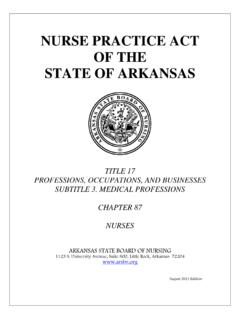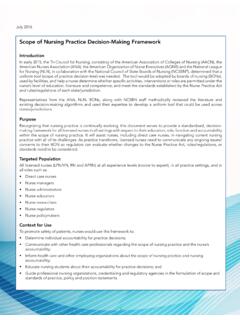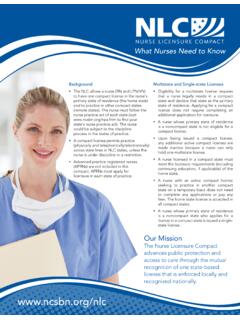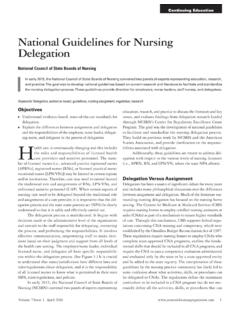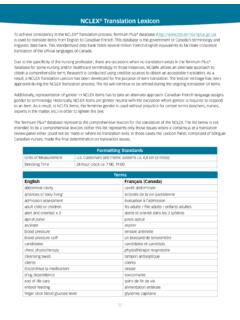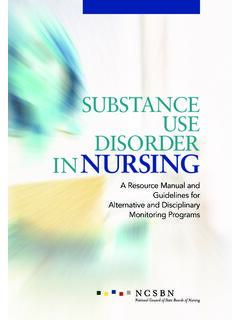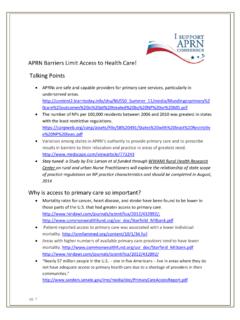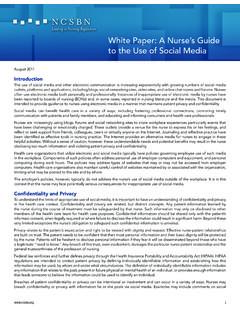Transcription of Outline of NCSBN’s Transition to Practice (TTP) Modules
1 Outline of ncsbn s Transition to Practice (TTP) ModulesINTRODUCTION The goal of ncsbn s Transition to Practice (TTP) Model is to promote public safety by supporting newly licensed nurses during their critical entry period and progression into Principles The mission of boards of nursing (BONs) is to protect public health, safety and welfare. Nursing regulators recognize the value of evidence-based models in their responsibility of public protection. Transitioning new nurses to Practice is best accomplished when Practice , education and regulation collaborate.
2 Transition to Practice programs should occur across all settings and education levels. Regulation criteria for Transition programs should reflect minimum requirements and be the least burdensome criteria consistent with public protection. Transition program outcomes are consistent with the knowledge, skills and attitudes required for safe and effective provision of nursing DefinitionsAdverse Incidents Any untoward, undesirable, and usually unanticipated event, such as death of a patient, an employee, or a visitor in a healthcare organization.
3 (Ebright et al., 2004)Clinical Reasoning The ability to reason as a clinical situation changes, taking into account the context and concerns of the patient and family. (Benner et al., 2010)Competent The ability to demonstrate an integration of the knowledge, skills and attitudes necessary to function in a specific role and work setting. (Modified from American Association of Critical-Care Nurses Preceptor Handbook)Errors Incidents or occurrences that had the potential to place a patient at risk for harm or resulted in actual Learning Repeated and active experience with similar situations to improve performance.
4 (Bj rk & Kirkevold, 1999)Failure to Rescue The inability to save a patient s life after the development of a complication. (Ashcraft, 2004)Near Miss An event or situation that could have resulted in an accident, injury, or illness, but did not, whether by chance or through timely intervention. (Ebright et al., 2004)Orientation The process of introducing staff to the philosophy, goals, policies, procedures, role expectations, and other factors needed to function in a specific work setting. Orientation takes place both for new employees and when changes in nurses roles, responsibilities, and Practice settings occur.
5 (American Nurses Association, 2000)Preceptor A nurse who has had preceptor training and is assigned to work with the newly licensed nurse for the first six months of Practice to provide expert feedback, to foster reflective Practice , to role model safe and quality patient care, and to socialize the novice nurse into the role of a nurse. The preceptor can work on a one-to-one basis with the new graduate, or some institutions might utilize a team preceptorship An active thinking back upon one s experience for the purpose of improving to Practice A formal program of active learning implemented across all settings, for newly licensed nurses (registered nurses [RNs] and licensed practical/vocational nurses [LPN/VNs]) designed to support their progression from education to ncsbn s TTP toolkit for further information about the ncsbn 1111 E.
6 Wacker Drive, Ste. 2900 Chicago, IL 60601 Main Fax 2 CONTENT OF MODULESThe following module outlines include the objectives, content outlines, suggested exercises and references for the five evidence-based Modules that were developed for the Transition to Practice model: Communication and Teamwork; Patient-centered Care; Evidence-based Practice ; Quality Improvement; and addition, there is a module for preceptor training and some information about how employers can support newly licensed nurses in the last six months of the new graduate s first year in Practice .
7 Integrated in the patient-centered care module are ideas for employers to consider for supporting the learning of specialty content. Research has suggested that Transition programs are more successful when they provide experiential learning within the specialty where the newly licensed nurse is working. Safety and clinical reasoning were specifically considered when designing all the Modules , and have been integrated throughout. Similarly, strategies for providing feedback and opportunities for reflection during the new nurses first year in Practice have been identified.
8 It has been the vision that ncsbn s Transition to Practice Model is flexible; that is, employing agencies can develop the Transition program, incorporating the standards as spelled out in the ncsbn Modules . Employers are encouraged to partner with other organizations that hire new nurses or with academic settings in order to develop their own Modules . However, since this is a regulatory model that requires new nurses to complete a standardized Transition program before they can renew their license after the first year of Practice , the online Modules will be available so that every newly licensed nurse will have the opportunity to meet this requirement.
9 Similarly, preceptor training is required in this model and there are a number of programs available where preceptors could meet this requirement. ncsbn s Transition to Practice Model has been designed to promote experiential learning, rather than relearning material that should have been learned in the nursing program. Interactive exercises have been developed to promote this in the face-to-face programs. Further, the online Modules will be designed to encourage experiential learning. In these interactive online Modules , the new nurses will make decisions, set priorities and choose appropriate pathways using cutting- edge technologies.
10 3 REFERENCESW hile each module is followed by a list of resources, the following are some general sources that support ncsbn s Transition to Practice Model:Barton, A. J., Armstrong, G., Preheim, G., Gelmon, S. B., & Andrus, L. C. (2009). A national Delphi to determine developmental progression of quality and safety competencies in nursing education. Nursing Outlook, 57, , P. E., Malloch, K., & Sheets, V. (Eds.) (2010). Nursing pathways for patient safety. St. Louis, MO: Mosby , L., Gilbert, M. A., & Lausten, G. R. (2010).
